|
Inouye Jukichi
Ogawa Kazumasa (Halftone Plates):
The Japan - China War: Compiled from Official and Other Sources by Jukichi Inouye, with Numerous Photo-Engraving Plates by K. Ogawa, Yokohama, Kelly & Walsh, Meiji 28 (1895), 8vo (7 3/4 x 10 3/8 in - 19.5 x 26.2 cm), decorated cloth covers with beveled edges, page edges in gilt, gold speckled end papers, text in English, 76 black and white halftone plates (6 of which span two pages), 92 pages of text (24 pp, 37 pp, 31 pp). This book is rather unique in that it was published just months after the events it described. Japan and China were locked in conflict over control of Korea from August of 1894 through April of 1895 and this book presents a contemporaneous and well illustrated Western language account of the war that had just concluded.
Part 1. The Naval Battle of Haiyang (5 page preface, plate list, 24 pages of text, 24 plates + 1 map with 5 additional diagrams/figures). This part deals with the naval battle of Haying between the Japanese and Chinese Squadrons in the Yellow Sea on September 17, 1894. This engagement pitted two relatively even heavily armored fleets of ironclad warships in battle which lasted from noon to dark. There was no clear cut winner and at the close both fleets withdrew and discontinued contact. The battle is recounted from the Japanese official Japanese accounts and unofficial Chinese accounts drawn primarily from writings of Westerners in the service of the Chinese.
Part 2. On the Regent's Sword (2 page preface, plate list, 37 pages of text, 25 plates + 3 maps). This part is an account of the activities of the Second Japanese Army on the Kinchow Peninsula for the period from September 15, 1894 through December 1, 1894. It presents the Japanese version of events in the battles of Kinchow, Port Arthur and Talienwan. The preface notes that "...all reference to alleged atrocities at Port Arthur has been avoided as the heated controversy to which they have given rise has not yet subsided and it would be impossible to give an impartial account in the face of contradictory allegations that have been put forward."
Part 3. The Fall of Wei-hai-wei (1 page plate list, 31 pages of text, 21 plates + 2 maps). An account of the last major series of battles of the Japan China war, the battle of Wei-hai-wei. The remnants of the Chinese Navy were sheltered in Wei-hai-wei. The Japanese Army and Navy closed on Wei-hai-wei and engaged and defeated the Chinese land and sea forces in January through early February of 1895. This book outlines both the land and Naval battles that ensued. The Chinese fleet at Wei-hai-wei consisted of 15 major naval vessels which included the ironclad battleships Ting-yuen and Chen-yuen and a number of torpedo boats. The Japanese Navy arrayed 25 men-of-war and 16 torpedo boats against the Chinese. Both of the ironclads were destroyed and the Chinese Navy was either destroyed or captured.
Type of Plates. The main title page states "Numerous Photo-Engraving Plates." The term photo-engraving denotes halftone plates. It is interesting to note that the title page for each of the three parts describes the plates as collotype. The plates in this book are halftone plates, not collotypes. Initially this series was printed in standalone format with cardboard wraps. In that format the plates were collotypes. However, in the consolidated edition, or at least in this one, the plates are all black and white halftones. The difference between the plates in this volume and the standalone book is shown below.
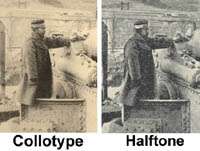
For more information on K. Ogawa, click here.
Statistics
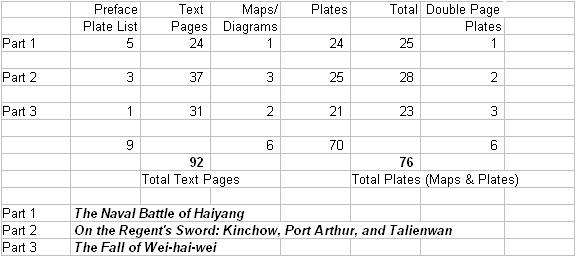
Title Page for All Parts.

Title Page for Part 1 (The Naval Battle of Haiyang).
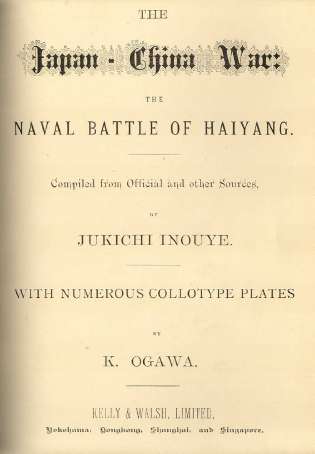
Title Page for Part 2 (On the Regent's Sword:
Kinchow, Port Arthur, and Talienwan).
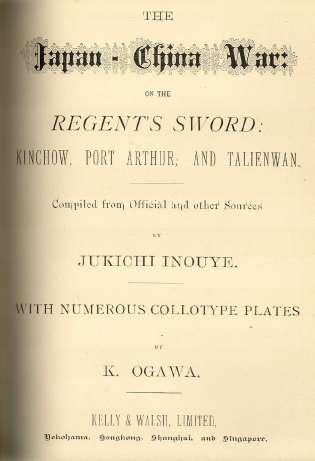
Title Page for Part 3 The Fall of Wei-hai-wei.
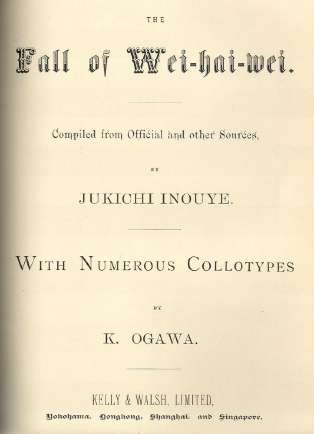
For information on Kazumasa Ogawa, click here.
|
|
Plates, Part 1 (The Naval Battle of Haiyang)
Plates, Part 2 (On the Regent's Sword: Kinchow, Port Arthur, and Talienwan)
Plates, Part 3 (The Fall of Wei-hai-wei)
All Plates, Part 1 - 3
Plates (Part 1 - The Naval Battle of Haiyang)
I. Diagrams showing the Movements of the Squadrons,
with a Map of the Scene of action. (Double Page -
a small map with 5 additional diagrams/figures)
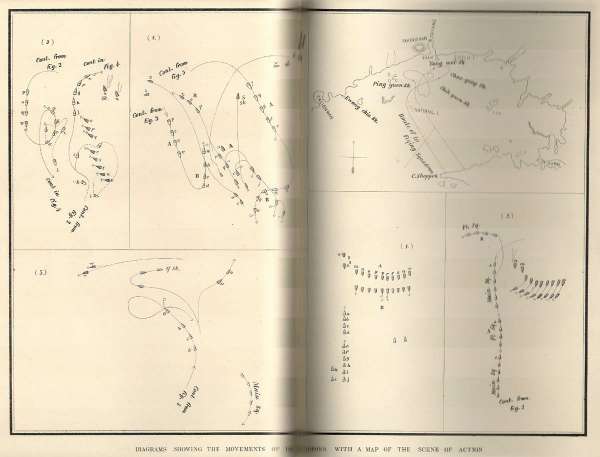 II. Admiral Count Saigo, Japanese Minister of War and Navy.
Vice-Admiral Ito, Commander of the Japanese Standing Squadron.
Vice- Admiral Viscount Kabayama, Chief of the Japanese Naval General Staff.
II. Admiral Count Saigo, Japanese Minister of War and Navy.
Vice-Admiral Ito, Commander of the Japanese Standing Squadron.
Vice- Admiral Viscount Kabayama, Chief of the Japanese Naval General Staff.
 III. Count Li-Hungehang, Minister of War and Viceroy of Chihli.
Admiral Ting-Joochang, Commander of the Chinese Peiyang Squadron.
Koo-Keshing, Chief of the Chinese Naval General Staff.
III. Count Li-Hungehang, Minister of War and Viceroy of Chihli.
Admiral Ting-Joochang, Commander of the Chinese Peiyang Squadron.
Koo-Keshing, Chief of the Chinese Naval General Staff.
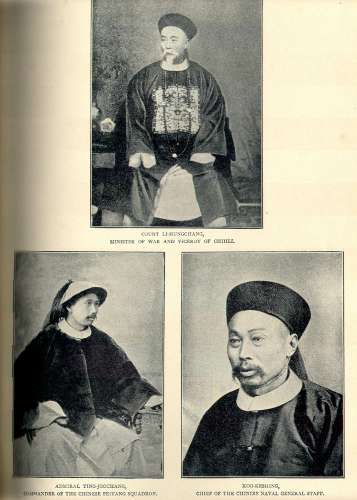 IV. The Matsushima after the Battle.
The Matsushima; the great Canet Gun.
IV. The Matsushima after the Battle.
The Matsushima; the great Canet Gun.
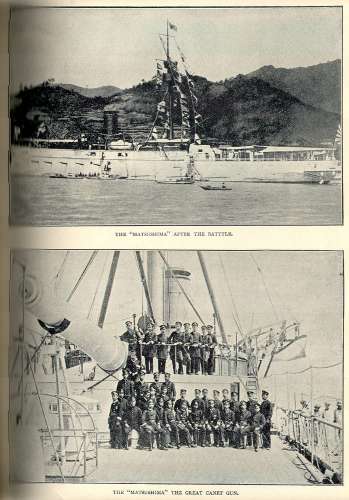 V. Captain Omoto, Commander of the Matsushima.
Late Commander Sakamoto, Commander of the Akagi.
Lieutenant Sato, Chief Navigating Officer of the Akagi.
VI. The Despatch-boat Akagi at Nagasaki after the Battle.
V. Captain Omoto, Commander of the Matsushima.
Late Commander Sakamoto, Commander of the Akagi.
Lieutenant Sato, Chief Navigating Officer of the Akagi.
VI. The Despatch-boat Akagi at Nagasaki after the Battle.
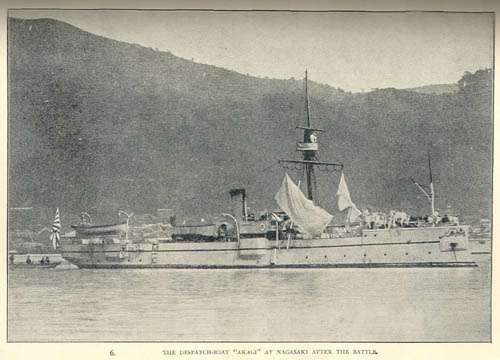 VII. The Akagi after the Battle, showing the effect of a shell on
the Shield of the fourth gun.
VIII. The Naval Battle. -- Photographed from the Saikyo-maru (1).
IX. The Akagi after the Battle, showing the damages on the
Starboard quarterdeck.
VII. The Akagi after the Battle, showing the effect of a shell on
the Shield of the fourth gun.
VIII. The Naval Battle. -- Photographed from the Saikyo-maru (1).
IX. The Akagi after the Battle, showing the damages on the
Starboard quarterdeck.
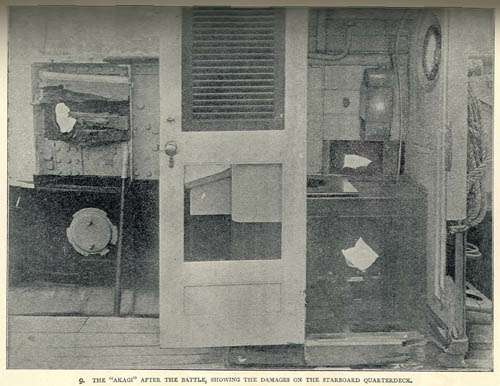 X. The Naval Battle. -- Photographed from the Saikyo-maru (2).
XI. The Battle of Haiyang. -- Reproduced from a Drawing by
Shin-ichiro Nakamura.
X. The Naval Battle. -- Photographed from the Saikyo-maru (2).
XI. The Battle of Haiyang. -- Reproduced from a Drawing by
Shin-ichiro Nakamura.
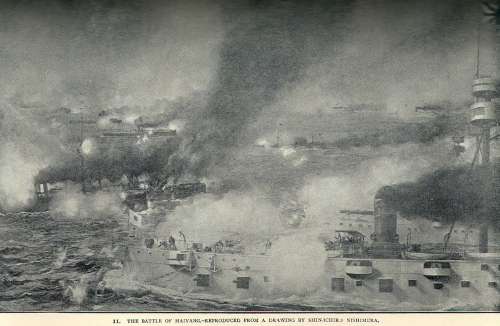 XII. The Chinese Battleship Chen-yuen.
The Chinese Battleship Ting-uyen.
XIII. The Naval Battle.-- Photographed from the Saikyo-maru.
The Chinese Man-of-war King-yuen (sunk).
XIV. The Chinese Cruiser Chin-yuen (sunk).
The Chinese Cruiser Yany-wei (sunk).
XII. The Chinese Battleship Chen-yuen.
The Chinese Battleship Ting-uyen.
XIII. The Naval Battle.-- Photographed from the Saikyo-maru.
The Chinese Man-of-war King-yuen (sunk).
XIV. The Chinese Cruiser Chin-yuen (sunk).
The Chinese Cruiser Yany-wei (sunk).
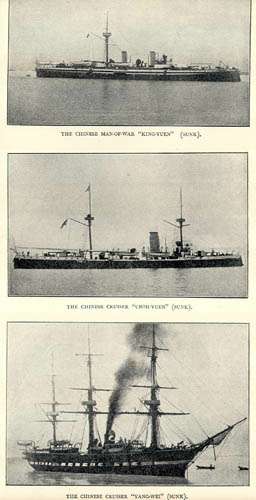 XV. The Burning of the Chao-yung. -- Photographed from the Saikyo-muru.
XVI. The Akagi after the Battle, showing the damages to the Main-mast
and Funnel.
XVII. The Japanese Cruiser Yoshino.
XV. The Burning of the Chao-yung. -- Photographed from the Saikyo-muru.
XVI. The Akagi after the Battle, showing the damages to the Main-mast
and Funnel.
XVII. The Japanese Cruiser Yoshino.
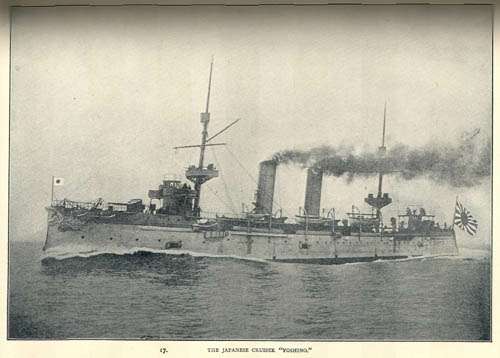 XVIII. On board the Saikyo after the Battle.
XVIII. On board the Saikyo after the Battle.
 XIX The Japanese Cruiser Hiyei
The Japanese Merchant Cruiser Saikyo.
XX. The Saikyo after the Battle, showing the damaged Hatchway.
XXI. The Base of Operations of the Imperial Japanese Navy.
XXII. The Base of Operations of the Imperial Japanese Navy.
XIX The Japanese Cruiser Hiyei
The Japanese Merchant Cruiser Saikyo.
XX. The Saikyo after the Battle, showing the damaged Hatchway.
XXI. The Base of Operations of the Imperial Japanese Navy.
XXII. The Base of Operations of the Imperial Japanese Navy.
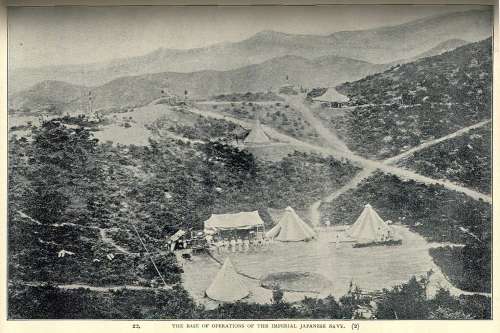 XXIII. The Japanese Itsukushima.
XXIV. The Matsushima, after the Battle, firing a Salute.
XXV. The Naval Battle Japanese Marines firing Machine Guns.
XXIII. The Japanese Itsukushima.
XXIV. The Matsushima, after the Battle, firing a Salute.
XXV. The Naval Battle Japanese Marines firing Machine Guns.
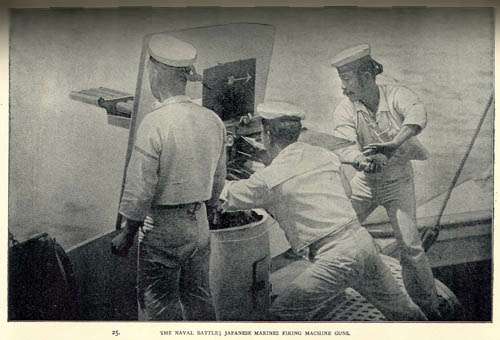 Maps/Plates (Part 2 - On the Regent's Sword:
Kinchow, Port Arthur, and Talienwan))
Maps (Not listed in the "List of Plates"):
The Regent's Sword
Maps/Plates (Part 2 - On the Regent's Sword:
Kinchow, Port Arthur, and Talienwan))
Maps (Not listed in the "List of Plates"):
The Regent's Sword
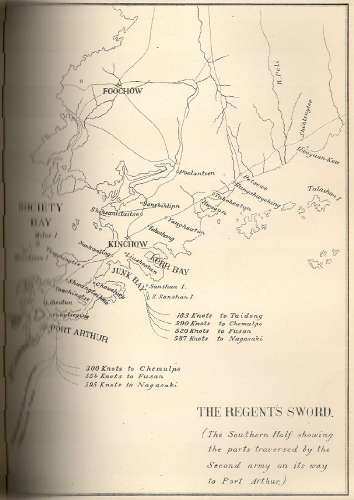 Shingking (2 pages)
Shingking (2 pages)
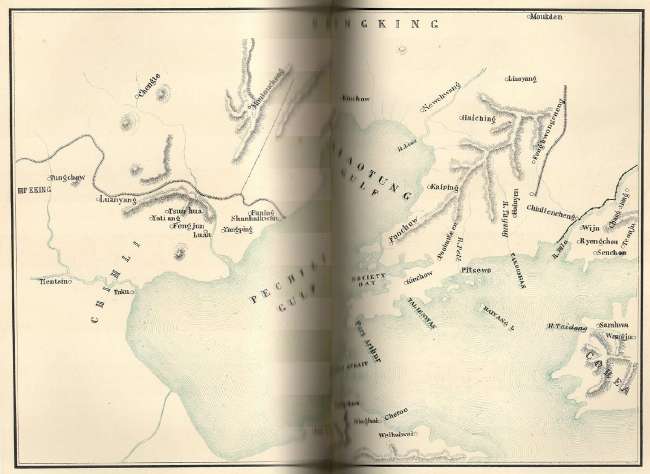 Environs of Port Arthur
Environs of Port Arthur
 Frontispiece Attack of the Field Artillery on Kinchow.
I. Men-of-war and Transports at anchor off Hwayuan-kow.
Frontispiece Attack of the Field Artillery on Kinchow.
I. Men-of-war and Transports at anchor off Hwayuan-kow.
 II. Provisions landed at Hwayuan-kow.
Temporary Pier at Hwayuan-kow at full tide.
II. Provisions landed at Hwayuan-kow.
Temporary Pier at Hwayuan-kow at full tide.
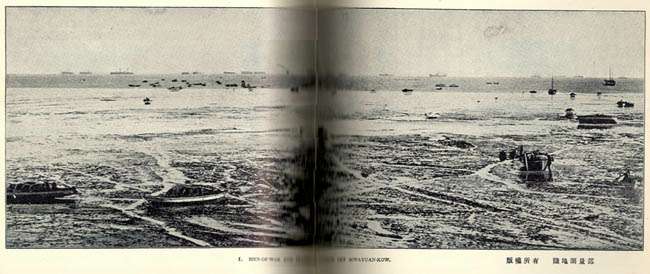 III. The Encampment at Hwayuan-kow.
Landing Provisions at Hwayuan-kow.
IV. The Beach at Petsewo at low-tide.
The same at high-tide.
V. The Second Regiment, Infantry, before the walls of Kinchow.
III. The Encampment at Hwayuan-kow.
Landing Provisions at Hwayuan-kow.
IV. The Beach at Petsewo at low-tide.
The same at high-tide.
V. The Second Regiment, Infantry, before the walls of Kinchow.
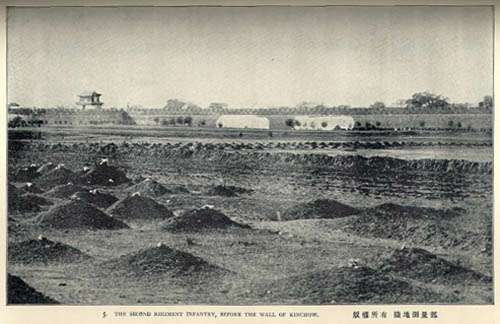 VI Chinese Dead on a Field near Kinchow.
Examination of Prisoners after the Occupation of Kinchow.
VI Chinese Dead on a Field near Kinchow.
Examination of Prisoners after the Occupation of Kinchow.
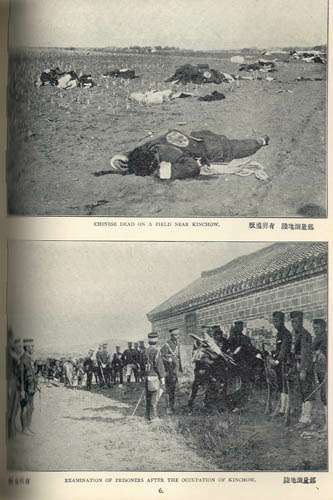 VII. The Pier at Liushootun, Talienwan.
VII. The Pier at Liushootun, Talienwan.
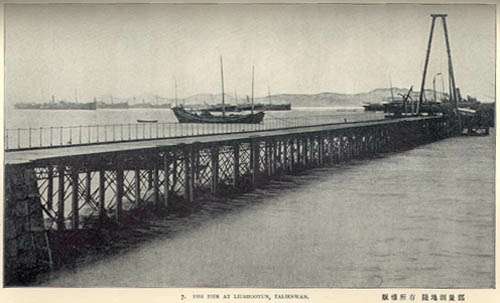 VIII. View of the Fort at Hoshang, Talienwan.
IX. Interior of the Hoshang Fort, Talienwan.
X. The First Division at Shwangtaikow.
VIII. View of the Fort at Hoshang, Talienwan.
IX. Interior of the Hoshang Fort, Talienwan.
X. The First Division at Shwangtaikow.
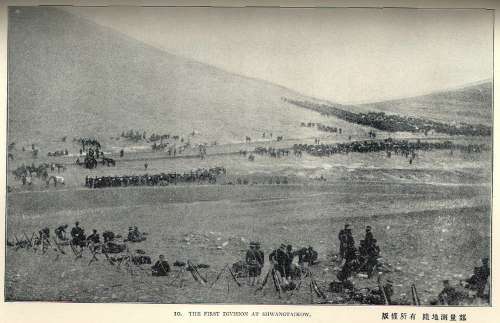 XI. The First Regiment of Artillery firing upon the enemy come to
attack the Second Regiment, Infantry.
The smoke on the right hill is from the Field Artillery and that
on the left from the Mountain Artillery, while the Infantry is
about to extend on the foreground.
XII. The Ambulance Corps carrying away the dead from Toochingtse.
XI. The First Regiment of Artillery firing upon the enemy come to
attack the Second Regiment, Infantry.
The smoke on the right hill is from the Field Artillery and that
on the left from the Mountain Artillery, while the Infantry is
about to extend on the foreground.
XII. The Ambulance Corps carrying away the dead from Toochingtse.
 XIII. The First Regiment, Infantry, in occupation of the Camp
deserted by the Enemy at Fongheatun, near Port Arthur.
XIV. In the Camp of the Second Army on the Eve of the Attack on
Port Arthur, from a Drawing by T. Asai.
XV. A Company of Mountain Artillery firing at Fongheatun, near Port Arthur.
XVI. Barracks of the Kiangtse Troops at Port Arthur.
XIII. The First Regiment, Infantry, in occupation of the Camp
deserted by the Enemy at Fongheatun, near Port Arthur.
XIV. In the Camp of the Second Army on the Eve of the Attack on
Port Arthur, from a Drawing by T. Asai.
XV. A Company of Mountain Artillery firing at Fongheatun, near Port Arthur.
XVI. Barracks of the Kiangtse Troops at Port Arthur.
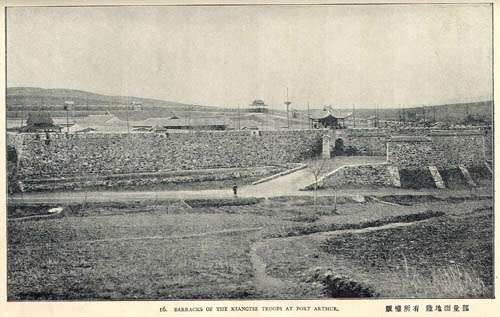 XVII. View of the Tiger's Tail Promontory. (Right-half).
XVIII. View of the Tiger's Tail Promontory. (Left-half.)
On the right is Chingtow Fort; next to it in the distance is the
Mantow Fort; to the left of it is the Mante Fort, below which
are barracks, while in the distance on the left is to be seen
the Lighthouse Department.
XIX. Muster of the First Regiment and portion of the Fifteenth Regiment
at Sooheatun, near Kinchow.
XX. View of the Entrance to Port Arthur from the Mantseying Fort.
The Hwangkin Forts on the right and the Tiger's Tail in the centre.
XXI. Bird's eye View of Port Arthur.
XVII. View of the Tiger's Tail Promontory. (Right-half).
XVIII. View of the Tiger's Tail Promontory. (Left-half.)
On the right is Chingtow Fort; next to it in the distance is the
Mantow Fort; to the left of it is the Mante Fort, below which
are barracks, while in the distance on the left is to be seen
the Lighthouse Department.
XIX. Muster of the First Regiment and portion of the Fifteenth Regiment
at Sooheatun, near Kinchow.
XX. View of the Entrance to Port Arthur from the Mantseying Fort.
The Hwangkin Forts on the right and the Tiger's Tail in the centre.
XXI. Bird's eye View of Port Arthur.
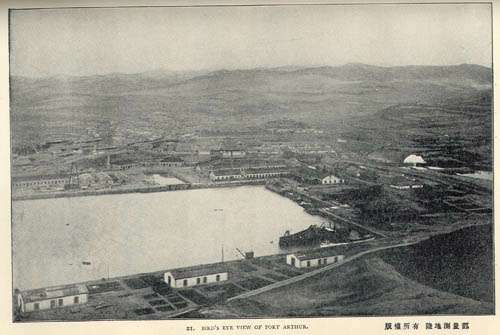 XXII. A Chinese Play at Port Arthur.
XXII. A Chinese Play at Port Arthur.
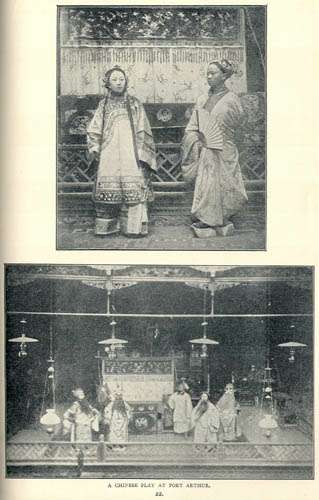 XXIII. Officers celebrating their Victory at the Dockyard at Port Arthur.
XXIV. A Funeral Service outside the East Gate of Kinchow.
Maps/Plates (Part 3 - The Fall of Wei-hai-wei))
Maps (Not listed in the "List of Plates"):
Pechili Gulf & Yellow Sea
XXIII. Officers celebrating their Victory at the Dockyard at Port Arthur.
XXIV. A Funeral Service outside the East Gate of Kinchow.
Maps/Plates (Part 3 - The Fall of Wei-hai-wei))
Maps (Not listed in the "List of Plates"):
Pechili Gulf & Yellow Sea
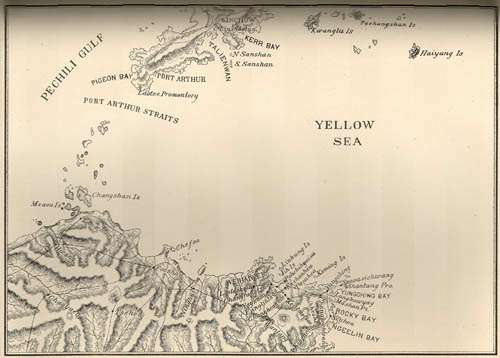 Wei-hai-wei and it's Environs (2 pages)
Wei-hai-wei and it's Environs (2 pages)
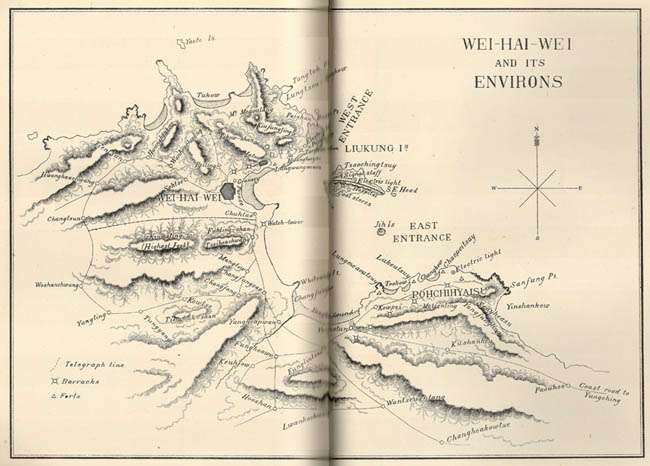 Frontispiece. Two Guns at the Hwangtoo-yay Fort on the N.W.
coast of Wei-hai wei
Frontispiece. Two Guns at the Hwangtoo-yay Fort on the N.W.
coast of Wei-hai wei
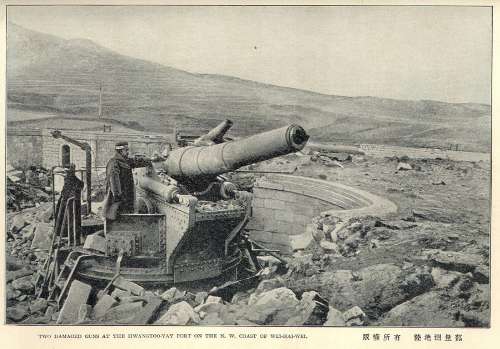 I. Second fleet of Japanese warships and transports on
their way from Falienwan to Yungching Bay
II. Landing of the provisions train of the Second Division
at Lungshwy Bay, Yungching
I. Second fleet of Japanese warships and transports on
their way from Falienwan to Yungching Bay
II. Landing of the provisions train of the Second Division
at Lungshwy Bay, Yungching
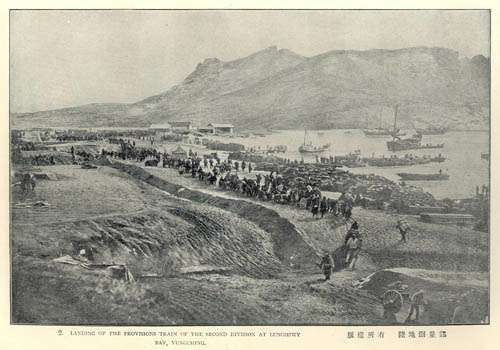 III. Advance of the Second Army staff upon Yung-Ching
IV. A Portion of the shelter trenches on Motienling, on
the E. coast of Wei-Hai-Wei
III. Advance of the Second Army staff upon Yung-Ching
IV. A Portion of the shelter trenches on Motienling, on
the E. coast of Wei-Hai-Wei
 V. The Chaopeitsuy Forts on the E. coast of Wei-Hai-Wei
VI. The Chaopeitsuy Forts on the E. coast of Wei-Hai-Wei (different view)
VII Chinese Men-of-War near Yangheya Sea firing on a portion
of the Fifth Infantry Regiment (double page)
V. The Chaopeitsuy Forts on the E. coast of Wei-Hai-Wei
VI. The Chaopeitsuy Forts on the E. coast of Wei-Hai-Wei (different view)
VII Chinese Men-of-War near Yangheya Sea firing on a portion
of the Fifth Infantry Regiment (double page)
 VIII. Attack made by the forts at Jih Island and the South-Eastern
Head of Liukung Island
IX. A portion of the eminence to the left of the Tseszetai
forts on the W. Coast of Wei-Hai-Wei
X. A rear view of the Peishantsuy forts, on the W. coast of Wei-Hai-Wei
XI. The destruction by shells of the torpedo-station on Peishantsuy,
on the W. coast of Wei-Hai-Wei
VIII. Attack made by the forts at Jih Island and the South-Eastern
Head of Liukung Island
IX. A portion of the eminence to the left of the Tseszetai
forts on the W. Coast of Wei-Hai-Wei
X. A rear view of the Peishantsuy forts, on the W. coast of Wei-Hai-Wei
XI. The destruction by shells of the torpedo-station on Peishantsuy,
on the W. coast of Wei-Hai-Wei
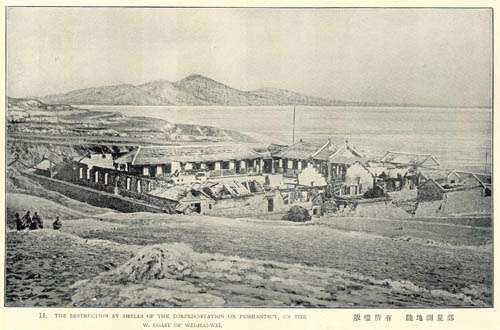 XII. The Chinese men-of-war firing in reply to the attack of a
portion of the Japanese squadron (double page)
XIII. The signal and electric light towers on Liukung Island
XIV. Lieut. Mano of the torpedo-boat no. 9
Lieut. Yoshioka of the torpedo-boat no. 21
Lieut. Nakamura of the torpedo-boat no. 10
The torpedo-boat no. 19 (3 portraits + image of boat)
XII. The Chinese men-of-war firing in reply to the attack of a
portion of the Japanese squadron (double page)
XIII. The signal and electric light towers on Liukung Island
XIV. Lieut. Mano of the torpedo-boat no. 9
Lieut. Yoshioka of the torpedo-boat no. 21
Lieut. Nakamura of the torpedo-boat no. 10
The torpedo-boat no. 19 (3 portraits + image of boat)
 XV. Discharging a torpedo / Disturbance of the surface by the
movement of a torpedo through water
XVI The great Chinese warship "Ting-yuen" after being destroyed by the
Japanese torpedo-boats off the southern shore of Liukung Island
XV. Discharging a torpedo / Disturbance of the surface by the
movement of a torpedo through water
XVI The great Chinese warship "Ting-yuen" after being destroyed by the
Japanese torpedo-boats off the southern shore of Liukung Island
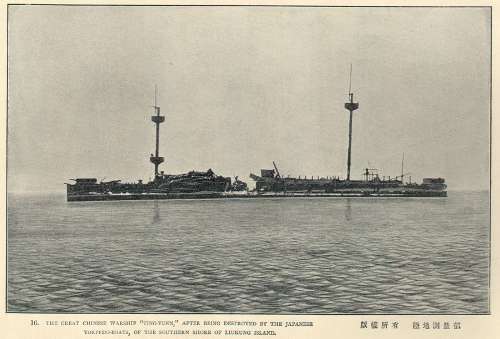 XVII. The Chinese man-of-war "Wei-yuen" lying sunk before the pier
at Liukung Island
XVIII. The Chinese men-of-war replying to the attack of the Japanese
seige-guns on a hill to the W. of Peishantsuy, W. of the
W. Entrance to Wei-Hai-Wei Harbour (2 pages)
XVII. The Chinese man-of-war "Wei-yuen" lying sunk before the pier
at Liukung Island
XVIII. The Chinese men-of-war replying to the attack of the Japanese
seige-guns on a hill to the W. of Peishantsuy, W. of the
W. Entrance to Wei-Hai-Wei Harbour (2 pages)
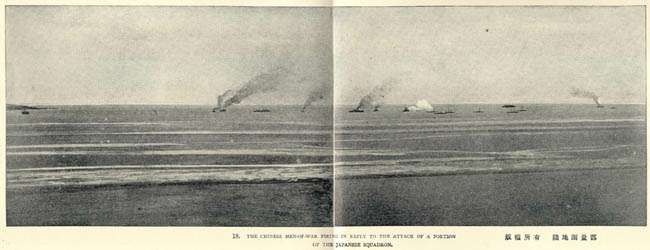 XIX. The Chinese men-of-war gathering on the water S.W. of Hwang Island
aftr the sinking of the "Ching-yuen"
XX. The landing of Chinese prisioners at Wei-Hai-Wei
XIX. The Chinese men-of-war gathering on the water S.W. of Hwang Island
aftr the sinking of the "Ching-yuen"
XX. The landing of Chinese prisioners at Wei-Hai-Wei
Colophon

Printed: Meiji 28(1895).10.4
Distributed: Meiji 28 (1895).10.8
|



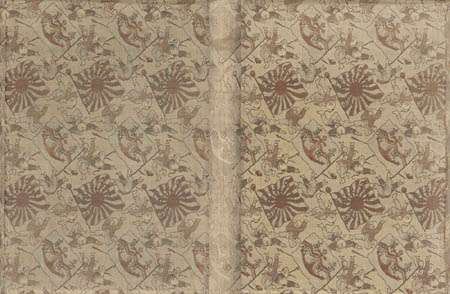








 VII. The Akagi after the Battle, showing the effect of a shell on
the Shield of the fourth gun.
VIII. The Naval Battle. -- Photographed from the Saikyo-maru (1).
IX. The Akagi after the Battle, showing the damages on the
Starboard quarterdeck.
VII. The Akagi after the Battle, showing the effect of a shell on
the Shield of the fourth gun.
VIII. The Naval Battle. -- Photographed from the Saikyo-maru (1).
IX. The Akagi after the Battle, showing the damages on the
Starboard quarterdeck.
 X. The Naval Battle. -- Photographed from the Saikyo-maru (2).
XI. The Battle of Haiyang. -- Reproduced from a Drawing by
Shin-ichiro Nakamura.
X. The Naval Battle. -- Photographed from the Saikyo-maru (2).
XI. The Battle of Haiyang. -- Reproduced from a Drawing by
Shin-ichiro Nakamura.

 XV. The Burning of the Chao-yung. -- Photographed from the Saikyo-muru.
XVI. The Akagi after the Battle, showing the damages to the Main-mast
and Funnel.
XVII. The Japanese Cruiser Yoshino.
XV. The Burning of the Chao-yung. -- Photographed from the Saikyo-muru.
XVI. The Akagi after the Battle, showing the damages to the Main-mast
and Funnel.
XVII. The Japanese Cruiser Yoshino.
 XVIII. On board the Saikyo after the Battle.
XVIII. On board the Saikyo after the Battle.
 XIX The Japanese Cruiser Hiyei
The Japanese Merchant Cruiser Saikyo.
XX. The Saikyo after the Battle, showing the damaged Hatchway.
XXI. The Base of Operations of the Imperial Japanese Navy.
XXII. The Base of Operations of the Imperial Japanese Navy.
XIX The Japanese Cruiser Hiyei
The Japanese Merchant Cruiser Saikyo.
XX. The Saikyo after the Battle, showing the damaged Hatchway.
XXI. The Base of Operations of the Imperial Japanese Navy.
XXII. The Base of Operations of the Imperial Japanese Navy.

 Maps/Plates (Part 2 - On the Regent's Sword:
Kinchow, Port Arthur, and Talienwan))
Maps (Not listed in the "List of Plates"):
The Regent's Sword
Maps/Plates (Part 2 - On the Regent's Sword:
Kinchow, Port Arthur, and Talienwan))
Maps (Not listed in the "List of Plates"):
The Regent's Sword





 VI Chinese Dead on a Field near Kinchow.
Examination of Prisoners after the Occupation of Kinchow.
VI Chinese Dead on a Field near Kinchow.
Examination of Prisoners after the Occupation of Kinchow.
 VII. The Pier at Liushootun, Talienwan.
VII. The Pier at Liushootun, Talienwan.
 VIII. View of the Fort at Hoshang, Talienwan.
IX. Interior of the Hoshang Fort, Talienwan.
X. The First Division at Shwangtaikow.
VIII. View of the Fort at Hoshang, Talienwan.
IX. Interior of the Hoshang Fort, Talienwan.
X. The First Division at Shwangtaikow.

 XIII. The First Regiment, Infantry, in occupation of the Camp
deserted by the Enemy at Fongheatun, near Port Arthur.
XIV. In the Camp of the Second Army on the Eve of the Attack on
Port Arthur, from a Drawing by T. Asai.
XV. A Company of Mountain Artillery firing at Fongheatun, near Port Arthur.
XVI. Barracks of the Kiangtse Troops at Port Arthur.
XIII. The First Regiment, Infantry, in occupation of the Camp
deserted by the Enemy at Fongheatun, near Port Arthur.
XIV. In the Camp of the Second Army on the Eve of the Attack on
Port Arthur, from a Drawing by T. Asai.
XV. A Company of Mountain Artillery firing at Fongheatun, near Port Arthur.
XVI. Barracks of the Kiangtse Troops at Port Arthur.

 XXII. A Chinese Play at Port Arthur.
XXII. A Chinese Play at Port Arthur.
 XXIII. Officers celebrating their Victory at the Dockyard at Port Arthur.
XXIV. A Funeral Service outside the East Gate of Kinchow.
Maps/Plates (Part 3 - The Fall of Wei-hai-wei))
Maps (Not listed in the "List of Plates"):
Pechili Gulf & Yellow Sea
XXIII. Officers celebrating their Victory at the Dockyard at Port Arthur.
XXIV. A Funeral Service outside the East Gate of Kinchow.
Maps/Plates (Part 3 - The Fall of Wei-hai-wei))
Maps (Not listed in the "List of Plates"):
Pechili Gulf & Yellow Sea



 III. Advance of the Second Army staff upon Yung-Ching
IV. A Portion of the shelter trenches on Motienling, on
the E. coast of Wei-Hai-Wei
III. Advance of the Second Army staff upon Yung-Ching
IV. A Portion of the shelter trenches on Motienling, on
the E. coast of Wei-Hai-Wei
 V. The Chaopeitsuy Forts on the E. coast of Wei-Hai-Wei
VI. The Chaopeitsuy Forts on the E. coast of Wei-Hai-Wei (different view)
VII Chinese Men-of-War near Yangheya Sea firing on a portion
of the Fifth Infantry Regiment (double page)
V. The Chaopeitsuy Forts on the E. coast of Wei-Hai-Wei
VI. The Chaopeitsuy Forts on the E. coast of Wei-Hai-Wei (different view)
VII Chinese Men-of-War near Yangheya Sea firing on a portion
of the Fifth Infantry Regiment (double page)

 XII. The Chinese men-of-war firing in reply to the attack of a
portion of the Japanese squadron (double page)
XIII. The signal and electric light towers on Liukung Island
XIV. Lieut. Mano of the torpedo-boat no. 9
Lieut. Yoshioka of the torpedo-boat no. 21
Lieut. Nakamura of the torpedo-boat no. 10
The torpedo-boat no. 19 (3 portraits + image of boat)
XII. The Chinese men-of-war firing in reply to the attack of a
portion of the Japanese squadron (double page)
XIII. The signal and electric light towers on Liukung Island
XIV. Lieut. Mano of the torpedo-boat no. 9
Lieut. Yoshioka of the torpedo-boat no. 21
Lieut. Nakamura of the torpedo-boat no. 10
The torpedo-boat no. 19 (3 portraits + image of boat)



